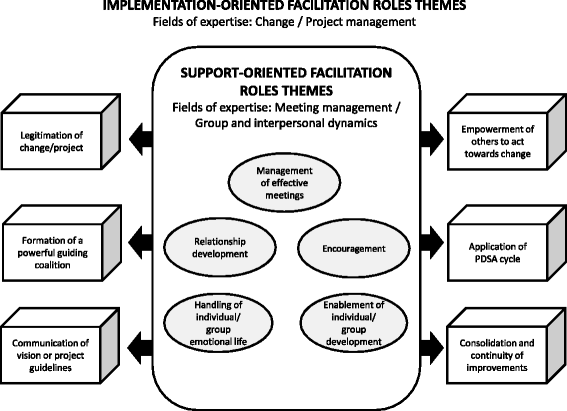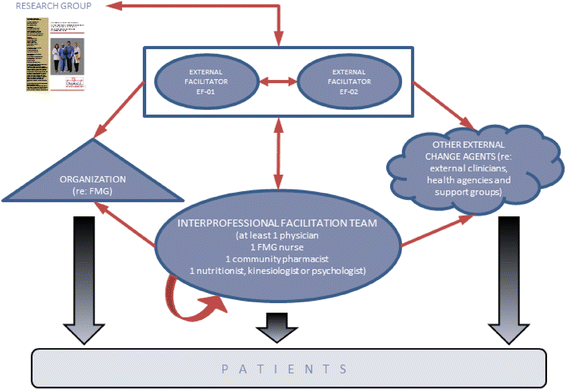External facilitators and interprofessional facilitation teams: a qualitative study of their roles in supporting practice change
- PMID: 27424171
- PMCID: PMC4947272
- DOI: 10.1186/s13012-016-0458-7
External facilitators and interprofessional facilitation teams: a qualitative study of their roles in supporting practice change
Abstract
Background: Facilitation is a powerful approach to support practice change. The purpose of this study is to better understand the facilitation roles exercised by both external facilitators and interprofessional facilitation teams to foster the implementation of change. Building on Dogherty et al.'s taxonomy of facilitation activities, this study uses an organizational development lens to identify and analyze facilitation roles. It includes a concise definition of what interprofessional facilitation teams actually do, thus expanding our limited knowledge of teams that act as change agents. We also investigate the facilitation dynamics between change actors.
Methods: We carried out a qualitative analysis of a 1-year process of practice change implementation. We studied four family medicine groups, in which we constituted interprofessional facilitation teams. Each team was supported by one external facilitator and included at least one family physician, one case manager nurse, and health professionals located on or off the family medicine group's site (one pharmacist, plus at least one nutritionist, kinesiologist, or psychologist). We collected our data through focus group interviews with the four teams, individual interviews with the two external facilitators, and case audit documentation. We analyzed both predetermined (as per Dogherty et al., 2012) and emerging facilitation roles, as well as facilitation dynamics.
Results: A non-linear framework of facilitation roles emerged from our data, based on four fields of expertise: change management, project management, meeting management, and group/interpersonal dynamics. We identified 72 facilitation roles, grouped into two categories: "implementation-oriented" and "support-oriented." Each category was subdivided into themes (n = 6; n = 5) for clearer understanding (e.g., legitimation of change/project, management of effective meetings). Finally, an examination of facilitation dynamics revealed eight relational ties occurring within and/or between groups of actors.
Conclusions: Facilitation is an approach used by appointed individuals, which teams can also foster, to build capacity and support practice change. Increased understanding of facilitation roles constitutes an asset in training practitioners such as organizational development experts, consultants, facilitators, and facilitation teams. It also helps decision makers become aware of the multiple roles and dynamics involved and the key competencies needed to recruit facilitators and members of interprofessional facilitation teams.
Keywords: Change agent; Change implementation; Dynamics; Facilitation; Facilitation team; Roles.
Figures


Similar articles
-
Clinicians as novice facilitators: a SIMPLE case study.J Health Organ Manag. 2019 Mar 18;33(1):78-92. doi: 10.1108/JHOM-03-2018-0071. Epub 2018 Oct 30. J Health Organ Manag. 2019. PMID: 30859913
-
Qualitative evaluation of the implementation of the Interdisciplinary Management Tool: a reflective tool to enhance interdisciplinary teamwork using Structured, Facilitated Action Research for Implementation.Health Soc Care Community. 2015 Jul;23(4):437-48. doi: 10.1111/hsc.12173. Epub 2014 Dec 19. Health Soc Care Community. 2015. PMID: 25522769
-
Key components of external facilitation in an acute stroke quality improvement collaborative in the Veterans Health Administration.Implement Sci. 2015 May 14;10:69. doi: 10.1186/s13012-015-0252-y. Implement Sci. 2015. PMID: 25971405 Free PMC article.
-
Following a natural experiment of guideline adaptation and early implementation: a mixed-methods study of facilitation.Implement Sci. 2012 Feb 6;7:9. doi: 10.1186/1748-5908-7-9. Implement Sci. 2012. PMID: 22309743 Free PMC article. Review.
-
Leadership in interprofessional health and social care teams: a literature review.Leadersh Health Serv (Bradf Engl). 2018 Oct 1;31(4):452-467. doi: 10.1108/LHS-06-2016-0026. Epub 2018 Mar 15. Leadersh Health Serv (Bradf Engl). 2018. PMID: 30234446 Review.
Cited by
-
Knowledge implementation in health care management: a qualitative study.BMC Health Serv Res. 2020 Mar 6;20(1):188. doi: 10.1186/s12913-020-5043-8. BMC Health Serv Res. 2020. PMID: 32143627 Free PMC article.
-
Specifying and comparing implementation strategies across seven large implementation interventions: a practical application of theory.Implement Sci. 2019 Mar 21;14(1):32. doi: 10.1186/s13012-019-0876-4. Implement Sci. 2019. PMID: 30898133 Free PMC article.
-
Qualitative methods in implementation research: An introduction.Psychiatry Res. 2019 Oct;280:112516. doi: 10.1016/j.psychres.2019.112516. Epub 2019 Aug 10. Psychiatry Res. 2019. PMID: 31437661 Free PMC article.
-
How Type of Practice Ownership Affects Participation with Quality Improvement External Facilitation: Findings from EvidenceNOW.J Gen Intern Med. 2022 Mar;37(4):793-801. doi: 10.1007/s11606-021-07204-7. Epub 2022 Jan 3. J Gen Intern Med. 2022. PMID: 34981342 Free PMC article.
-
Implementing team huddles in small rural hospitals: How does the Kotter model of change apply?J Nurs Manag. 2018 Jul;26(5):571-578. doi: 10.1111/jonm.12584. Epub 2017 Dec 17. J Nurs Manag. 2018. PMID: 29250892 Free PMC article.
References
-
- Larsen JA, Maundrill R, Morgan J, Mouland L. Practice development facilitation: an integrated strategic and clinical approach. Practice Development in Health Care. 2005;4:142–149. doi: 10.1002/pdh.9. - DOI
-
- Stetler CB, Legro MW, Rycroft-Malone J, Bowman C, Curran G, Guihan M, Hagedorn H, Pineros S, Wallace CM. Role of “external facilitation” in implementation of research findings: a qualitative evaluation of facilitation experiences in the Veterans Health Administration. Implement Sci. 2006;1:23. doi: 10.1186/1748-5908-1-23. - DOI - PMC - PubMed
-
- Simmons M. ‘Facilitation’ of practice development: a concept analysis. Practice Development in Health Care. 2004;3:36–52. doi: 10.1002/pdh.121. - DOI
Publication types
MeSH terms
LinkOut - more resources
Full Text Sources
Other Literature Sources

